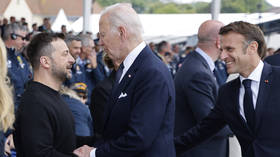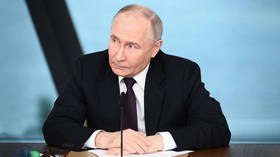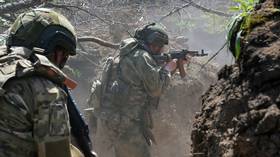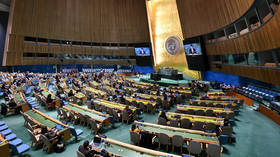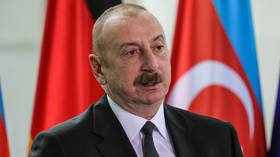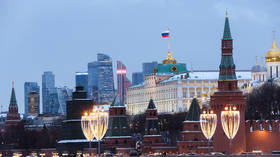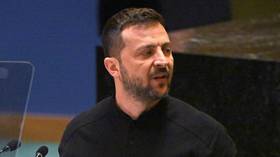Russia fears a NATO attack. Here’s why.
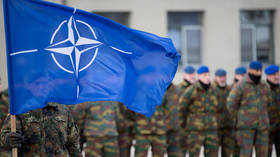
The possibility of a trans-European war is closer today than at any time since the mid-20th century. Western analysts discuss various scenarios of a possible conflict, while officials openly speculate about its likelihood and even discuss specific time horizons.
In a recent speech, Russian President Vladimir Putin declared that the actions of Western governments had brought the world “to the point of no return.” At the same time, domestic debate in Russia is dominated by the belief that the US and its allies recognize the catastrophic risks of a direct military confrontation with Moscow and will seek to avoid it for reasons of self-preservation.
Such judgments are based on the assumption that the West, despite its aggressiveness and arrogance, is guided in its policies by a rational balance of benefits and costs based on the existing balance of power. Past experience, however, does not convince us that the US-led bloc is capable of pursuing a balanced, calculated course.
Throughout the 2000s and 2010s, the West repeatedly became involved in military adventures from which it then painfully sought a way out. One need only recall the examples of the interventions in Afghanistan, Iraq, and Libya. Of course, in all these cases, the risks were significantly lower than in the case of a hypothetical war with Russia. But the stakes were also significantly lower.
A recent admission by US President Joe Biden is telling: “If we ever let Ukraine fail, mark my words, you will see Poland go, and you will see all these countries along Russia’s actual border negotiate on their own.” Thus, the good old ‘domino theory’ is back in the minds of Western strategists.
The divided consciousness of the West
The growing bitterness of Western countries towards Russia is consistent with the way in which they look at armed conflicts in terms of the logic of preventive war. Rather than linking interstate clashes to aggressive opportunism, this model sees escalation as a product of fears about the future. The belief that their situation will deteriorate over time leads states to take increasingly adventurous steps, up to and including the use of force.
Throughout history, major wars have usually been the product of this preemptive logic – the desire to strike before an expected weakening. For example, the collapse of the continental blockade system led Napoleon to attack Russia. German fears about the prospects for modernization of the Russian army were the trigger for the First World War.
A similar dynamic can be seen today in the policy of the West, which has invested considerable resources in confronting Russia.
The fact that Moscow doesn’t countenance losing in any way, but, on the contrary, is gradually moving towards achieving its goals, can only lead to frustration on the part of the US and its allies. This does not lead to reconciliation, but to the search for more effective means to hinder Russia.
Having failed in its plans to destroy the Russian economy with restrictive measures and to inflict a strategic defeat on Moscow at the hands of Kiev, the West is moving ever closer to the brink of direct military confrontation. At the same time, it is becoming increasingly insensitive to the possible consequences of such a scenario. Like casino players, the US and its allies are raising the stakes with each successive bet.
The growing adventurism is clearly visible in the debate over the deployment of Western troops in Ukraine. Moreover, not only hysterical Western European leaders, but also seemingly more responsible American generals have begun to speak out on the issue. For example, the head of the US Joint Chiefs of Staff, Charles Brown, has concluded that the deployment of NATO troops to the country is inevitable.
The West’s willingness to take risks is reinforced by its contradictory, if not schizophrenic, view of Russia. Public figures never tire of claiming that Moscow’s potential was greatly overestimated in the past and has been further weakened by the Ukraine operation. At the same time, without being aware of the dissonance, they justify the build-up of their own armed forces on the grounds of an increased Russian threat. An Irish writer once labelled this sort of thinking as “Russophrenia.”
The inconsistency is also evident in the portrayal of Russia as an insatiable expansionist intent on invading its neighbours, combined with a belief in its reverence for Article 5 of the Washington Treaty, which guarantees that NATO members will provide mutual assistance in the event of an attack on one of them.
The portrayal of Russia as a ‘paper tiger’ – an aggressive but weak actor – lays the groundwork for pre-emptive escalations to reverse the trends of confrontation unfavorable to the West. And they can be carried out not only in Ukraine.
The idea of restricting Moscow’s access to the Baltic Sea, which ignores the inevitable response to threats to Kaliningrad, is evidence of this, and is regularly introduced into Western discussions.
Quo Vadis?
So far, the idea of an armed attack on Russia has not been explicitly voiced by Western politicians. At present, they are talking about raising the stakes in the expectation that Moscow will not dare to respond. Moreover, the thesis that NATO and its member states do not want a direct military confrontation continues to be voiced. These assurances do not remove two kinds of danger.
First, the West can play with the reliability of nuclear deterrence and create such a provocation that Moscow will be forced to defend its vital interests with all available means. The aforementioned threats to close the Baltic Sea promise just such a flirtation.
Second, the established trend of increasing adventurism holds out the prospect of further policy shifts from the US and its allies. The logic of confrontation tends to raise the stakes, not least because of the accumulation of costs already incurred. As a result, the means available are beginning to dictate the objectives pursued.
Another factor increasing the risk of confrontation is the collective nature of the West. Domestic debates tend to emphasise the unequal nature of relations in NATO due to Washington’s clear dominance. Meanwhile, it is the vassal status of European states that increases their interest in escalation.
The prospect that Washington, preoccupied with competing with China, will lose interest in them and refocus on Asian affairs is a constant fear of its transatlantic allies. The embodiment of this dread is the figure of Donald Trump, but in European capitals there is a fear that this scenario will come to pass regardless of the personality of any particular leader.
US allies believe that time is working against them. Accordingly, the confrontation with Russia acquires an instrumental function, helping to justify keeping Washington’s attention on the European agenda. The debate in the US Congress over funding for Kiev in early 2024 has already become a wake-up call, demonstrating that the US is immersed in its own affairs.
Guided by the logic of anticipation, European NATO members may conclude that provoking a clash now, while the United States remains engaged in the conflict in Ukraine and containing Russia, is preferable to the prospect of bearing the burden of confronting Moscow alone in the future – a scenario they do not rule out.
Not surprisingly, the most irresponsible and radical proposals – such as sending troops to Ukraine or extending NATO guarantees to territory controlled by Kiev – come from Western European politicians. The internal dynamics within the West encourage competition for the status of the most intransigent fighter against Russia.
From plans to practice
In practice, NATO members are actively preparing for a military confrontation with Moscow. The bloc’s new force model, endorsed at the Madrid Summit in 2022, and the regional plans drawn up on its basis, envisage the deployment of a significant force of 300,000 troops within 30 days, in addition to those already stationed on Russia’s borders.
This is based on the active development and modernization of contingents from Central and Eastern European countries. Poland, which claims the same status as NATO’s main bastion that the Bundeswehr enjoyed in the second half of the 20th century, is particularly noteworthy in this respect. The increase to 300,000 troops is intended to make its armed forces the bloc’s largest land army among European member states.
NATO members are openly practising combat scenarios in potential theatres in Eastern and Northern Europe. Much emphasis is being placed on learning lessons from the armed struggle in Ukraine. To this end, a special center is being set up in Bydgoszcz, Poland, to ensure a regular exchange of experience between Western and Ukrainian military personnel.
The weak link in the Western effort has long been the limited capabilities of its military industry. Nevertheless, NATO members are paying increasing attention to overcoming this problem. It would be foolhardy to expect that they will not be able to increase production over time, including by increasing Western European firms’ links with the US military-industrial complex.
Describing the interim results of Western efforts, experts at the influential Washington-based Centre for Strategic and International Studies concluded in a recent report that NATO is ready for future wars. Such a resounding conclusion was accompanied by the clarification that the bloc still needs to work to prepare for a protracted confrontation that could lead to a clash with Russia.
Such contradictory expert conclusions are clearly dictated by political expediency – the desire to confirm the correctness of the chosen course of deterring Moscow, but at the same time the need to mobilize NATO member states to further increase efforts in the military sphere. They once again raise the stakes.
Finding the ‘golden mean’
In the case of the question posed in the title, analysis shows that the answer is likely to be positive. Russia faces the difficult task of containing escalation in a context of low receptivity to Western signals. Attempts to convey the seriousness of the situation are either dismissed out of hand or interpreted as manifestations of Russian aggressiveness.
In the face of such indoctrination, there is a danger that we ourselves will slip into a similar exaggeration, trying to force the enemy to abandon its adventurous line with even riskier demonstrations of resolve. So far, the Russian leadership has managed to resist these temptations.
Undoubtedly, Western attempts to raise the stakes must be responded to. At the same time, it makes sense to focus the damage on the NATO member states themselves, not just their proxies (the focus should be on the notorious “decision centers”). Statements about the possible transfer of long-range weapons to US adversaries and the visit of Russian ships to Cuba are logical steps in this direction.
Perhaps the range of responses could also include the shooting down of drones carrying out reconnaissance for Ukraine over the Black Sea. This would also allow for a total ban on their flights in the adjacent waters. Russian deterrence could also be complemented by maneuvers in the Baltic, Mediterranean or North Atlantic with other states that are considered to be Western adversaries.
The expectations from use of deterrence should be weighed against historical experience, which shows that the response to such actions is more often to harden the adversary than to encourage them to make concessions. In particular, this calls into question the validity of sometimes heard suggestions of nuclear strikes for demonstration purposes. Such actions are more likely to have the opposite effect to that envisaged by their authors, i.e. to bring direct military confrontation with NATO closer rather than further away.
This article was first published by the Valdai Discussion Club, translated and edited by the RT team.
